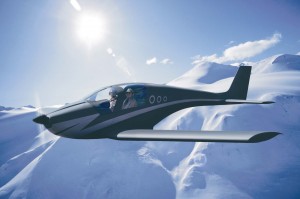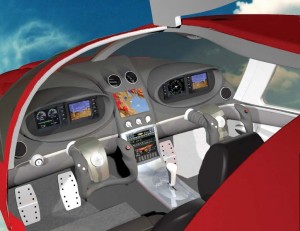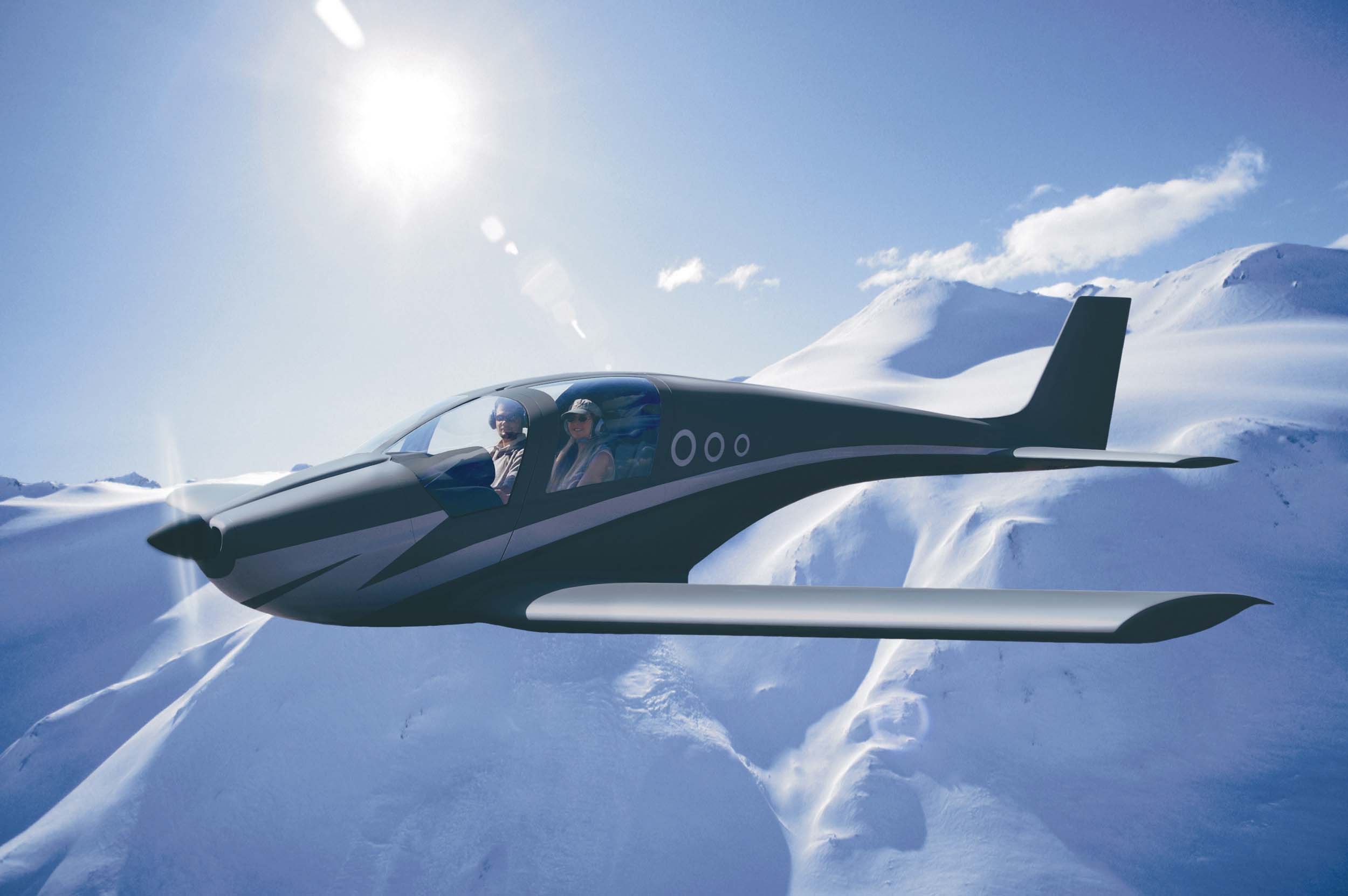By Lance Gurwell

In this computer simulation, the Nexaer LS1 flies over snow-covered mountaintops. Its service ceiling is still to be determined, but the plane is capable of maximum level-flight speed of 120 knots (138 mph).
The Nexaer LS1 is one of them, but you couldn’t tell by looking at it. “Them” is the new generation of light sport airplanes designed to give millions more people the opportunity to enjoy the freedom of flight, in planes that are lighter and can fly slower. Several LSA are already on the market, and they’re an attractive lot. There’s a replica of the Piper J-3 Cub, some look like pint-sized aerobatic planes, and some look similar to the Cessna 172, just smaller.
Then, there’s the Nexaer LS1. It doesn’t look like anything else in the sport airplane world. The gracefully arced fuselage looks a bit like a dolphin jumping from the water; the forward-sitting low wing does nothing to weaken the rakish fuselage, which tapers rearward to the stabilizer and rudder.
The LS1 is a carbon-fiber sculpture. When it was in the early design stage, Nexaer President Paul Klahn knew what he wanted. First, it had to comply with Federal Aviation Administration rules, but it also had to look completely unique. He would push the design envelope to develop an airplane that was safe and easy to fly—and as affordable as possible, within his design parameters.
“About 99.9 percent of the American public isn’t pilots,” Klahn said, sitting at a large table in a loft above his hangar/prototyping facility at Meadow Lake Airport near Falcon, Colo., about 10 miles northeast of Colorado Springs. “We want to expand that market through the sale of the LS1.”
But first, Klahn has to develop a flyable version of his plane. For the past few months he’s been working overtime, along with a crew of employees who sometimes labor for little more than stock in the company. They see the vision and he expects them to hang on.
A new approach to aircraft
The Nexaer LS1 is a comfortable and stylish two-seater designed with the customer in mind. Its sleek lines and 54-inch-wide cabin present a new and modern design, while somehow retaining a degree of familiarity that pilots will appreciate.
The LS1 will be offered in three versions: the standard edition, with standard mechanical instruments and a four-cylinder, 80-hp engine; a trainer edition with dual flight controls and an emergency all-plane parachute; and the luxury edition, with a glass cockpit configuration, autopilot, leather interior, and a six-cylinder 120-hp engine. The best part: prices for the standard edition are expected to start around $80,000, while prices for the high-end luxury edition will be in the range of $110,000.
“The luxury edition will really be a beautiful, fully equipped airplane with dual EFIS, dual GPS, full avionics, a digital autopilot, and an emergency all-plane parachute,” Klahn said. “It also includes a deluxe interior with leather upholstery, cabin carpet, and the all-important cup-holders.”
Perhaps the most striking feature of the LS1 is the unprecedented 54-inch-wide cockpit and 21-inch-wide automotive-style seats. Klahn explained one of the most important design goals was to create an aircraft that is truly comfortable and ergonomic, so that people will enjoy the experience of sitting inside the airplane, rather than feeling cramped and uncomfortable.
“The traditional aircraft design philosophy has been to reduce drag at all costs in order to maximize airspeed. Since the FAA has imposed a speed limit on light sport aircraft, the paradigm has changed,” Klahn said. “We’re not competing based on top speed; we’re competing on comfort and style, much like the auto industry. I believe we’re the first in our class to take this approach, and I believe we’re going to set the new benchmark.”

L to R: Cindy Klahn, Bill VonDane and Bryan Carr check the fit of a wing prior to mounting it to a fuselage and heading to the paint booth. All structural elements of the Nexaer LS1 or formed from carbon fiber.
The standard engine in the LS1 is a horizontally opposed four- or six-cylinder Jabiru aircraft engine manufactured in Australia. There will also be options for Lycoming, Continental and Rotax engines for customers requiring a certified aircraft engine. Any of those engines will fly the LS1 at 120 knots (138 mph), and provide a range of at least 550 miles. The higher-powered engines will significantly improve the takeoff and climb performance, and will be an attractive option for people based at high elevations or on short fields. With a 120-hp engine, Nexaer projects a maximum rate of climb in excess of 1,500 feet per minute, and a takeoff distance of about 350 feet (at standard sea level conditions).
Useful load with this aircraft ranges from 500 to 600 pounds, depending on the configuration. With full fuel and two average-sized adults, there is still room for about 50 pounds of baggage. With an eye toward recreation and lifestyle, Nexaer has incorporated baggage space that can accommodate golf clubs, skis and fishing poles.
“We don’t want people to just fly around the traffic pattern. We want people to be able to really use the airplane for travel and recreation,” said Klahn.
How they got here
Paul Klahn graduated from Western Michigan University, where he started off in a commercial pilot curriculum, and ended up with a degree in aeronautical engineering. After college, he went on to become an Air Force officer. His wife Cindy (Hustedde) Klahn is an Air Force Academy graduate with a master’s degree in mechanical engineering. She recently separated from the Air Force at the rank of major to devote full time to helping develop the Nexaer LS1.
Earlier in her Air Force career, she had an assignment in Germany. In 1998, Klahn resigned his Air Force commission so he could go to Germany with his wife.
“We decided while we were over there for two years that I would spend my time building a kit aircraft so we could see what the current level of technology was,” Klahn said.
He added that they already knew they wanted to get into the sport aircraft market, which was still very early in the planning stages.
Good things happened while they were in Europe. The Klahns were introduced to several faculty members at the University of Delft in the Netherlands, who were part of the university’s Center for Lightweight Structures. It was there that they learned about a relatively new composite fabrication process called “vacuum infusion,” and they began to consider its usefulness in manufacturing aerospace components.
Construction processes on existing light sport aircraft vary; some have metal skins, some are fiberglass. Klahn believes the Nexaer LS1 will be the only vacuum-infused carbon-fiber LSA on the market.
In cooperation with Enfusion Technologies, a Colorado Springs-based composite manufacturing company that will fabricate parts for the LS1, Nexaer has spent several years developing and perfecting its carbon-fiber vacuum infusion system. Klahn is certain this process gives Nexaer an edge in the sport plane market.
“The National Composites Center in Kettering, Ohio, has reported a 40 percent cost savings in parts produced with vacuum infusion versus traditional composite lay-up methods,” he said. “The quality and repeatability of infused parts falls right in line with current aerospace standards. The three major challenges we face with manufacturing light sport aircraft are cost, weight and quality. Vacuum infusion helps us control all three of these factors.”
Last May, Nexaer successfully completed its first round of private investments that got them through prototype development, test flight and a debut at EAA AirVenture Oshkosh, where Nexaer exhibited a full-scale mockup of the LS1. A finished prototype is scheduled to fly in October.
The goal for Oshkosh was to show off the airplane, generate publicity, and continue adding names to its order list. After the show, the Nexaer team returned home motivated to finish the control system installation, wiring and engine installation.
Support from the outside
Earlier this year, the Aircraft Owners and Pilots Association, the nation’s largest private general aviation pilot’s organization, invited manufacturers and owners of LSA to demonstrate the aircraft at its headquarters in Frederick, Md.
LSA from around the world, including Italy, Australia, the Czech Republic, and the U.S., converged at the Frederick Municipal Airport. Sport plane pilots gave demonstration flights and rides.
The event, organized in conjunction with the Light Aircraft Manufacturers Association, went a long way in giving LSA the credibility they deserve. By the time the meeting ended, a lot of minds had been changed.
When the FAA was defining the light sport aircraft category, it lumped the fixed wing airplanes in with other “recreational” aircraft such as powered parachutes and ultralights, which often aren’t held in the same light as traditional airplanes. Lumping LSA into a classification that even mentioned ultralights was like the kiss of death to many pilots who likened ultralights to toys—and dangerous ones at that, Klahn said.

This computer simulation of a Nexaer LS1 trainer features digital avionics. The plane is available in three levels—standard, trainer and luxury edition—but many options are available.
There was concern by many that the LSA classification expanded the class of experimental aircraft, and made it much too easy to get a pilot’s license. Much of the problem may have stemmed from language the Federal Aviation Administration used when it released its LSA rules for public comment in 2002. It described LSA as “simple, low-performance aircraft limited to 1,232 pounds maximum weight, a single non-turbine engine, stall speed of 39 knots, maximum airspeed of 115 knots, and fixed landing gear.”
Phil Boyer, AOPA president, clarified that “AOPA represents pilots and owners, from airline pilots to J-3 Cub owners (the J-3 Cub qualifies as a LSA under the FAA guidelines).”
“We are here to keep their flying safe, fun and affordable,” Boyer said in an article published on the organization’s website. “These airplanes open a wider door into general aviation flying. They cater not only to new students who are looking for a more affordable way to learn to fly, but also to veteran pilots who may want to get back to the joys of flying a simple, easy-to-handle airplane.”
The new sport pilot certificate, which allows pilots to fly light sport aircraft, can be obtained with about 20 hours of training. Sport pilots would also need either a third class medical certificate or a valid state driver’s license to fly.
The future
In July, Nexaer began exploring a distribution agreement with Salt Lake City-based Sportplanes.com to market the LS1.
“This new breed of aircraft is a perfect fit with the forward-looking program established by Sportsplanes.com,” said Sportplanes President Josh Foss. Sportsplanes.com also markets several other light sport aircraft.
Several LSAs are already on the market, but Foss is optimistic about Nexaer’s success.
“The Nexaer team is highly qualified and very impressive in their accomplishments,” said Foss. “They have defined a clear vision for the future and they have the wherewithal to make it all happen. The LS1 is a new generation in aircraft design that is beautiful, comfortable and affordable. This is an aircraft that will have a major impact on sport pilot licensing and the future of flight, as we know it in this country. We’re excited about the prospects that emerge with this vibrant design.”
Colorado Springs may not be the permanent home to Nexaer, Klahn said. While his company has admittedly flown under the radar during this early phase, he said he would soon begin looking for a community that is proactive in attracting new businesses and creating jobs.

One of the keys of keeping the cost of the Nexaer LS1 competitive, and at the same time light and strong, is the use of carbon fiber. Here, a technician prepares a wing mold for casting.
“We’re going to be searching for a permanent home, and when we’re ramped up and building at projected levels, we plan to create up to 300 new jobs in somebody’s back yard,” Klahn said.
There has been talk of a new industrial park near Colorado Springs International Airport, but Klahn says the reality of that development may not coincide with Nexaer’s timeline.
While work continues on the prototype, Nexaer engineers will continue refining its manufacturing process, making sure that all construction practices meet ASTM standards and FAA requirements. If everything goes according to plan, Klahn hopes to deliver the first production airplane within 18 months.
For more information Nexaer and the LS1, visit [http://www.nexaer.com], or call 719-648-9255.











